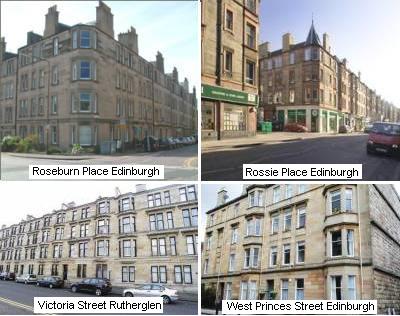Scotland's growth in heavy industries during the 19th century attracted thousands of workers from the Scottish Highlands and Ireland.
In many towns and cities, the tenement was seen as an improvement on the overcrowded existing accommodation. They were also seen as a way of getting many people into small areas of available space. The tenements often became overcrowded and insanitary, developing into slums. The Gorbals, on Glasgow's south side of the River Clyde, was one of the most notorious.
Most of Glasgow's traditional tenements were built between 1880-1914. The majority are four storey buildings, which in order to avoid the horizontal monotony of tenement architecture of the period, began to experiment with window spacing, then the notion of cornices and bay windows. The yellow sandstone marks them as being the early (mid-19th Century) phase of building while red sandstone tenements belong to the later (late 19th and/or early 20th Century) building phase. By 1919 190,000 tenement flats had been built in Scotland. Tracing the origins of the earliest blocks can be difficult as in many cases the street names came later than the buildings.
Large families were crammed into two rooms. Single-end flats were located on the corners and were smaller, but at least the rent was less. The population density was amongst the highest in Britain, and forced a sense of community spirit against a backdrop of squalor and hardship.
Coal had to be lifted up several storeys, and the shared toilets were located in outbuildings or in cubicles on the stairwell landings. This was a result of an 1892 Act requiring the compulsory provision of toilet facilities in all tenements.
 TB (tuberculosis - or consumption as it was also known) was endemic and spread with ease through the crowded communities. It affected those who had been poorly fed and were under nourished, also affecting those who lived in dirty and damp homes. In 1900, 30% of all deaths in Glasgow were from TB and other infectious diseases. Though accurate records are difficult to acquire, it is believed that TB killed one-third of all those who died in Britain between 1800 and 1850.
TB (tuberculosis - or consumption as it was also known) was endemic and spread with ease through the crowded communities. It affected those who had been poorly fed and were under nourished, also affecting those who lived in dirty and damp homes. In 1900, 30% of all deaths in Glasgow were from TB and other infectious diseases. Though accurate records are difficult to acquire, it is believed that TB killed one-third of all those who died in Britain between 1800 and 1850.
Tenement construction in the west of Scotland was of red or yellow sandstone but soon lost their colour from the smoke and soot of nearby industries. Much of Glasgow's sandstone was quarried in the Stranraer area and a great deal of Edinburgh's sandstone originated in Fife. The New Town stone came from the Craigleith quarry. In the past there were 600 sandstone quarries in Scotland; less than 10 survive today.
Many tenements still stand, but equally large numbers were demolished in the 1960's and 70's as part of urban redevelopments.
ADDITIONAL INFORMATION
The Tenement House - an early 20th-century Glasgow tenement preserved by the National trust for Scotland and open to the public.

HappyHaggis.co.uk ©